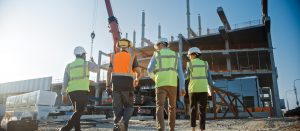Kevin Emerson, Utah Clean Energy’s Building and Decarbonization Director, recently moderated a panel featuring a powerhouse trio of Utah building experts. Damian Mora of Garbett Homes, Chris Zarek with Cowboy Partners, and Ivan Carrol of Giv Group came together to explore the new advancements and must-haves in the world of energy-efficient building.
Their insights laid the groundwork for how Utah can reimagine our built environment for healthier, more comfortable, climate-friendly homes and buildings. Let’s dive in.
Why are Buildings so Important?
The building sector is responsible for about 42% of annual global carbon dioxide emissions. With thousands of housing units being built in Utah each year, it’s critical to minimize this impact on emissions by building homes that produce low, and even zero emissions.
The United States Department of Energy (DOE) recognizes the need for low-impact buildings, and recently drafted the first national definition of a zero emissions building. It establishes that “zero emissions buildings” are 1) highly energy efficient, 2) free of on-site emissions from energy use, and 3) powered solely from clean energy.
How are Leading Homebuilders Pursing Low and Zero Emission Housing Today?
Garbett Homes proudly builds all of their homes to the Department of Energy’s Zero Energy Ready Home program standards. These are homes that are ultra energy efficient and all-electric. They’ve begun working toward zero emission homes, breaking ground on several zero emission projects this last year.
Staff at Giv Group have seen Utah’s air quality transition throughout their lifetimes, which became an impetus for their decision to go all-electric with their units in 2016. As they continue to push toward all-electric standards, they aim to show the market that it can pursue clean energy without hurting profits. Giv has found that constructing energy efficient, all-electric housing is cost competitive or cheaper than building traditional housing that includes gas combustion for space and water heating.
Cowboy Partners has also recently decided to move toward all-electric communities. The high utility costs of gas infrastructure helped motivate their shift, as well as their success using solar systems to handle the full electric load of some of their developments. They are now preparing to break ground on their first all-electric, urban community in September!
Each builder shares a commitment to energy efficient, and all-electric homebuilding. During the event, they assured attendees that all-electric appliances are perfectly effective, citing zero issues with their performance.
What Design, Construction, and Equipment Considerations are Crucial to High-Performance Building?
Industry leaders agree; some technologies are must-haves in building energy-efficient homes. Top picks include:
- Optimizing the building envelope (i.e. installing proper insulation, air sealing),
- Replacing gas cooking appliances,
- Installing high-performance technologies like air source heat pumps, heat pump water heaters, and energy and heat recovery ventilators,
- And EV readiness equipment rounds out the “must-have” list!
Together, these tools can transform a building into a sustainable fixture.
Knowledge is Power
All-electric homes are still not the norm, and any new technologies come with a learning curve. That is why builders may need to consider how they can help their tenants understand how their all-electric homes operate. For instance, some customers lack confidence in the performance of all-electric appliances like heat pumps and would prefer to use the gas furnaces they are used to. This isn’t because heat pumps are ineffective, but rather because many homebuyers aren’t familiar with how heat pumps work or how the experience of heating a home with a heat pump might be different. Builders can help address this wariness by providing educational and instructional materials to their tenants.
Where is the Industry Going?
Things look bright for the future of energy-efficient, low or zero emissions buildings in Utah. Tax credits and other incentives are available to help make homes energy efficient, solar powered, and electric. These can be coupled with Utility sponsored energy efficiency rebate programs to help on the financial front.
There’s a growing recognition that electric communities can be more resilient when compared to their gas counterparts. For example, all-electric homes can be more resilient during outages or extreme weather events than homes with gas heating. This is because some electric appliances can store hot water or heat for up to 24 hours at a time whereas gas appliances cannot, and gas infrastructure is increasingly “aging and vulnerable” to natural disasters.
The building industry also can’t ignore the demand for and market size growth of low-emission homes. That’s especially true In Utah where we contend with some of the worse air quality in the country. The good news is that once builders start the electric transition, they only save more money as they perfect the process and optimize efficiency over time.
Stay tuned as Utah continues its journey to low and zero emission housing. Exciting things are in store!






